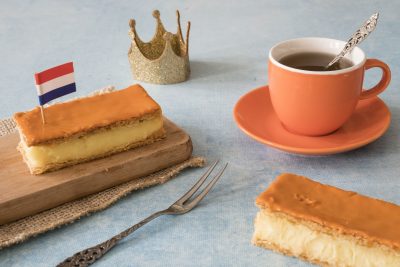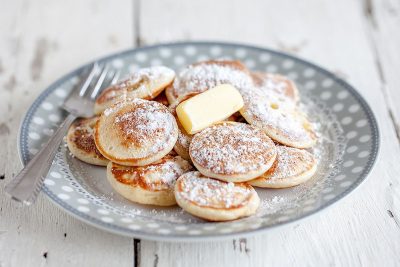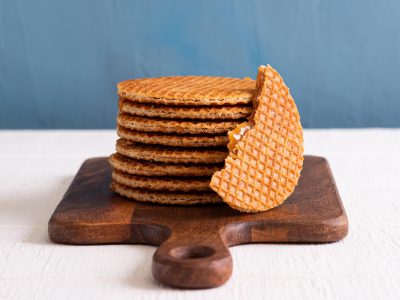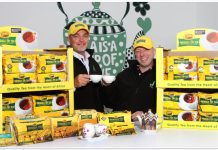While some borders are open for travel, many around the world remain closed as a result of the Covid-19 coronavirus pandemic. Some countries, like the Netherlands, are only allowing certain people into the country so if you’re not a citizen, health care professionals, permanent resident or on business within a permitted sector, travelling to the country is forbidden.
While many have put their travel plans on hold, it doesn’t mean that one can’t experience the magic of the Netherlands through food. Dessert is a popular course in the Netherlands and in a bid to bring the Netherlands into your own home, KLM Royal Dutch Airlines shares some mouth-watering recipes you should try to make from the safety of your own home.

Tompouce
The tompouce is the Dutch version of the mille-feuille. It’s an incredibly popular dish that is served at bakeries around the country all year round. However, there are some times when it’s become a custom to enjoy this tasty dish. On King’s Day, a national holiday celebrating the birthday of the country’s monarch, the top layer is dyed orange instead of the customary pink glaze.
Ingredients:
For the pastry cream:
2 cups of (soy) milk
1 vanilla bean
3/4 cup of sugar
4 egg yolks (save the egg whites for the icing!)
2 Tbsp flour
1 envelope gelatine (look for the Jello-O section at the store)
For the crispy layers:
2 square sheets of puff pastry (9″, from the freezer)
For the royal icing:
1 egg white
1/2 tsp vanilla extract
2 cups of powdered sugar
if desired, use some colourful sprinkles
Directions:
- Get a sauce pan and add the milk. Slice the vanilla bean open lengthwise with a knife and scrape the seeds and add the seeds to the milk and stir well. Add half of the sugar to the milk and bring to a boil.
- Whisk the other half of the sugar with the egg yolks in a bowl. Stir in the flour and pour a dash of warm milk to the egg yolk mixture, mix well and put it all in the (soft) boiling milk. Bring back to a boil and let it softly boil for 3 minutes.
- Turn off the gas and stir the gelatine in and pour the creamy mixture in a square dish, cover with plastic and let it cool off in the fridge for 2-3 hours.
- In the meantime, start with the puff pastry: first let them thaw on the counter for about 30 minutes. Unfold them and prick them all over with a fork.
- Preheat the oven to 180°C and bake the pastry for 20 minutes while you press down the dough every 5 minutes with a clean towel. This stops the dough from puffing up too much.
- After 20 minutes bring down the temperature to 150°C and bake another 10 minutes. Take the pasty out the oven, cut each sheet in 16 equal squares (so 32 in total) while they’re still hot and let them cool on a rack. Once cooled, you can start making the royal icing.
- In a large bowl combine the egg white with the vanilla extract until frothy. Gradually add the powdered sugar and mix on low speed until the sugar is incorporated and the mixture is shiny. Turn the speed up to high and beat until the mixture forms stiff, glossy peaks. This takes approximately 5 to 7 minutes.
- Pair the puff pastry squares in top and bottom layers and decorate the top squares with the icing. Decorate them with the sprinkles immediately.
- Now take the pastry cream out of the fridge, it should be a firm mixture, and transfer to a pastry bag or -again- use a storage bag with one of the corners cut out.
- Squirt the pastry cream on the bottom layer of the puff pastry. The cream layer should be around 2,5cm high. Finally, transfer the top icing layer onto the cream layer and you’re done.

Poffertjes
It’s no secret that the Dutch are obsessed with their pancakes. So much so, in fact, that savoury pancakes are more popular in the Netherlands than pizzas. Pancake houses are found all around the country and are often enjoyed both sweet and savoury. Poffertjes are a popular mini version of well-loved dish and are often found at market stalls and breakfast tables drizzled with melted butter and a sprinkling of icing sugar.
Ingredients:
150g buckwheat flour
100g all purpose flour
2 tablespoons caster sugar
350ml milk
Pinch of salt
7g packet dry yeast
1 egg beaten
2 tablespoons oil for greasing pan
2 tablespoons melted butter
Icing sugar for dusting
Directions:
- Heat the milk in a saucepan to warm, remove from the heat and mix in the caster sugar and the yeast. Set the pan aside for 5 – 10 minutes during which time the mixture will become foamy.
- Combine the flour and salt in a large mixing bowl and slowly add the yeast mixture, then the egg, to the flour and whisk until you have a smooth batter. Cover the bowl with a damp tea towel and allow it to rest for an hour, by which time it should have doubled in size.
- To make the pancakes pour the batter into a large jug and pour small quantities into a pan, you may prefer to use a tablespoon to spoon out the mixture.
- Heat a saucepan over medium-high heat. Grease the pan with some oil and spoon in a small amount of pancake batter at a time. The pancakes should be approximately 4cm in diameter, cook quickly on both sides and remove to a paper towel on a warm plate until you have made all the pancakes and are ready to serve.
- Once all the pancakes have been made transfer onto serving plates, drizzle with melted butter and dust with icing sugar.
- Serve immediately.
Boterkoek
Boterkoek, or butter cake, is another popular Dutch dish and is one of the sweetest delicacies you will find in the Netherlands. The cake is popular at coffee shops around the country because its dense consistency and rich taste means that it is usually served in small squares or tiny slices alongside a steaming cup of coffee.
Ingredients:
1 cup butter, softened
1 ½ cups white sugar
2 eggs, beaten
1 tablespoon almond extract
2 ½ cups all-purpose flour
2 teaspoons baking powder
Directions:
- Preheat the oven to 180°C Grease and grease two 20cm round cake pans
- In a large bowl, use an electric mixer to beat butter and sugar until light and fluffy. Add eggs, reserving just enough to brush over the tops, about 1 tablespoon. Stir in the almond extract. Combine the flour and baking powder; stir into the batter by hand using a sturdy spoon. The dough will be stiff.
- Press evenly into the two prepared pans. Brush the tops with a thin layer of the reserved egg.
- Bake in the preheated oven for about 30 minutes, or until the top is golden brown. Cut into squares and serve.

Stroopwafels
Another popular sugary snack from the Netherlands is a thin syrupy waffle called the stroopwafel. The confection is essentially a wafer cookie made from two thin layers of baked dough perfectly layered on top of each other separated by a sweet caramel filling. Today, stroopwafels are sold at markets, by street vendors and in supermarkets around the Netherlands and are a popular sweet treat with both tourists and locals.
Ingredients:
4 cups all-purpose flour
1 ⅛ cups butter, melted
¾ cup white sugar
2 sachets of active dry yeast
¼ cup warm milk
1 egg
1 ½ cups molasses
1 ⅓ cups packed brown sugar
⅓ cup butter
1 teaspoon ground cinnamon
Directions:
- In a large bowl, mix together the flour, melted butter, sugar, yeast, milk and egg. When the dough becomes too stiff to stir, turn out onto a floured surface and knead by hand for a few minutes. Set aside to rise for 45 minutes.
- To make the filling, heat the molasses, brown sugar, remaining butter and cinnamon in a saucepan over medium heat. Stir to blend, and set aside.
- Preheat a pizzelle iron. Knead the dough briefly, and divide the dough into 1cm balls, or a size compatible with your pizzelle iron pattern. Press the balls in the preheated iron, and cook until the iron stops releasing steam, or until the waffles are golden brown.
- Carefully remove with a knife or spatula, and split in half horizontally (like pocket bread) while they are still warm. Don’t wait too long, otherwise they will break. Spread filling on the insides, and put the halves back together.






